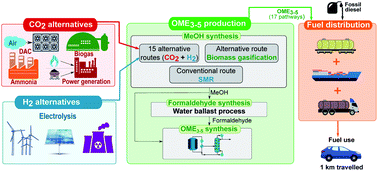Economic and life-cycle assessment of OME3–5 as transport fuel: a comparison of production pathways†
Abstract
Reducing the contribution of the transport sector to climate change calls for a transition towards renewable fuels. Polyoxymethylene dimethyl ethers (OMEn) constitute a promising alternative to fossil-based diesel. This article presents a comparative analysis of 17 OME3–5 production pathways, benchmarked against fossil-based diesel under environmental and economic criteria following a life-cycle approach. OME3–5 fuels that are reliant on biomass as feedstock, or use H2 produced from wind- or nuclear-powered electrolysis and CO2 from direct air capture, have the potential to reduce global warming impacts by up to 20%. Nevertheless, such fuels are also found to shift environmental burdens to other impact categories under human health and ecosystems quality due to procurement of raw materials (H2, CO2 and biomass), and their predicted total monetized cost is 1.5–3.6 times that of fossil-based diesel. These results highlight the need for embracing impacts beyond climate change in the environmental assessment of alternative fuels and including negative externalities in their economic assessment.

- This article is part of the themed collection: Recent Open Access Articles


 Please wait while we load your content...
Please wait while we load your content...